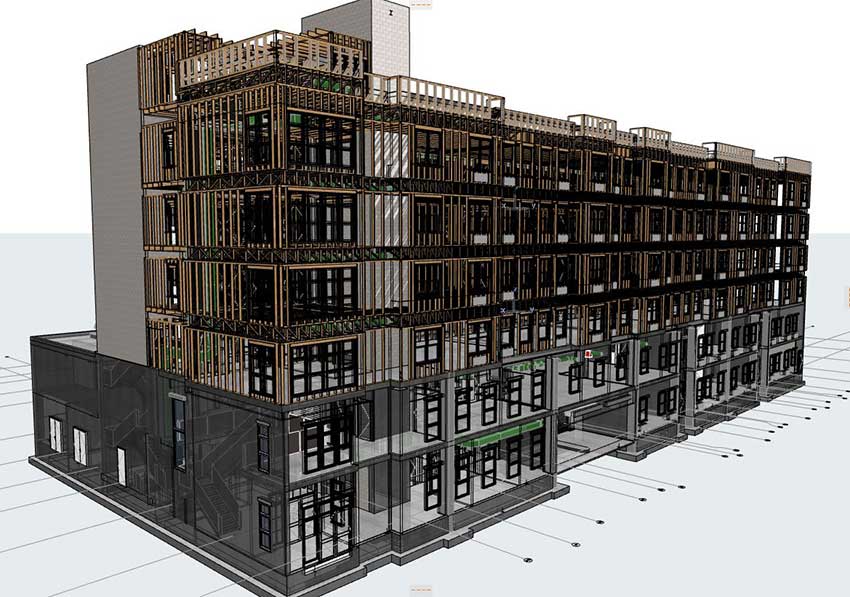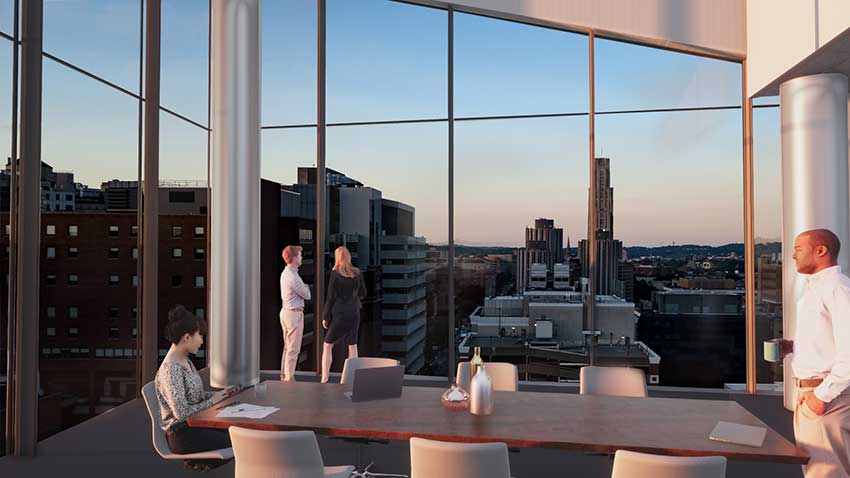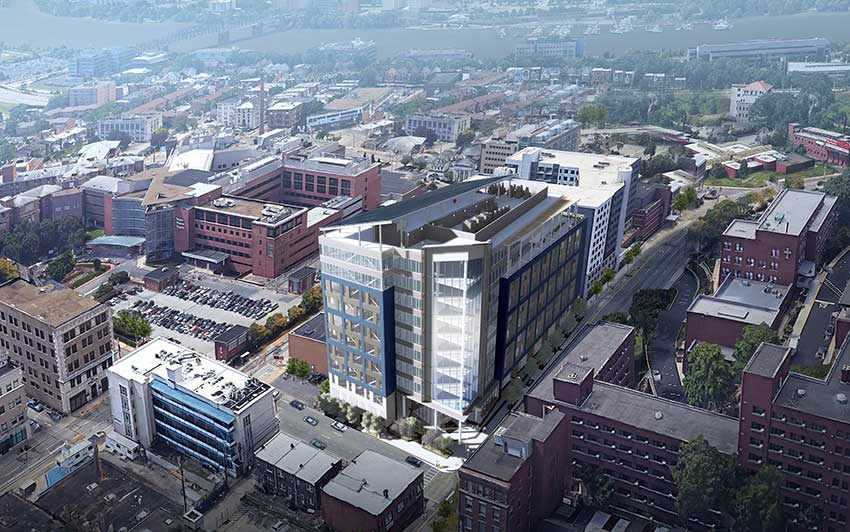Maximizing Returns in Real-Time
Case Study: Brook Street Lofts—A One-Team, One-Model Approach
Brook Street Lofts is a new construction, 245,000-square-foot, transit-oriented development in New Jersey. The six-story, mid-rise building consists of four floors of residential housing above two floors of noncombustible garage parking for building occupants as well as walk-up residential units on the first two floors along Brook Street. Brook Street Lofts contains a total of 146 residential units of mixed-income-family rental housing.

Image courtesy of Kitchen & Associates
Brook Street Lofts is a transit-oriented development in New Jersey that was designed by Kitchen & Associates, who used BIM to work in collaboration with out-of-house consultants, from Boise, Idaho, to Feasterville, Pa.
Unique to this project was the design team. Kitchen & Associates, based in Collingswood, New Jersey, worked with out-of-house consultants, collaborating with the Riverstone Structural Concepts team from Boise, Idaho, and the Holstein White MEP team from Feasterville, Pennsylvania.
The design team can take one project file from conceptual schematic sketches through construction documents. It uses a multitude of features and plug-ins that enable designers to create realistic renderings, video, and VR walk-throughs from one file. Users can communicate internally on the project within the database.
Like Fuse Architects, Kitchen & Associates transferred to a BIM platform when their firm and size of projects started growing. They needed something to produce design and documentation in a way that achieved profitability, coordination, and quality and met timelines.
In-house, K&A had a robust custom template, custom object library, and standards manual, but working with outside teams meant being able to import, export, and integrate. Though K&A has in-house MEP engineering, they had such a high volume of work that they needed to work with outside teams in addition to in-house. Working within the BIM software allowed for real-time collaboration for teams in three different places across the U.S.
The way BIM could update the structural model for designers and clients without document exchange was their biggest attraction to working with the tool. The engagement was a plus, and reviewing conflicts took less time, which kept projects on schedule and reduced costly mistakes and do-overs because everyone was on the same page—literally—from the beginning, addressing problems before permits were issued.
K&A notes that having everyone working in one model and streamlining the process still required—and encouraged—conversation. In other words, BIM helped with efficiency, but it did not automate the process; human engagement kept the project feeling alive and vibrant, but the communication system was easier and better. One element that helped nurture that engagement: the server chat function in some BIM programs, which can help keep communication fluid and remind everyone that they are part of a team. K&A found they could make some rules to help keep the team happy in this collaborative setting, one of which was: If you create something, you can edit it. If not, ask first.
Having each discipline in the same model, with everyone designing and modeling their respective building elements to size in 3D, helps the entire design team work more efficiently and more accurately. It cuts out the “dead time” of creating and sending PDFs and the back-and-forth review that emailing documents involves. Identifying coordination conflicts during the design phase results in fewer coordination issues in the field and a smoother construction process.
These small time-savers add up, K&A notes. They can cut out lots of time and reduce the budget, and the focus can be turned on the creative 3D collaboration—the heart of the project. For K&A, being able to have an architect and structural engineer in one file—and to have them both looking at the exact same view—cuts down coordination efforts that can sometimes spread out over weeks.
The accuracy aspect is also highly important. Architects and engineers working in the same 3D space clarifies design intent. Architects can see ductwork and plumbing, which can situate them in the design better to visualize how all the pieces of their design work together. It can provide another layer of education for all stakeholders, who are able to absorb the way another team works and the elements and parameters they deal with. It offers a well-rounded education through the experience of working in a holistic 3D model. That can help improve all aspects of building and improve the way each team might approach certain problems then and in the future.

Image courtesy of Strada
The Innovation Research Tower, a 10-story building located in the “innovation district” of Oakland, Pa., that was able to use a variety of BIM tools to experiment with curtain walls and develop a multitude of prototypes that would have otherwise taken too long to create and test.
UNCOVERING OPPORTUNITIES FOR SUSTAINABILITY
Architects are increasingly interested in reducing the environmental impact of the buildings they design—and for good reason. Buildings account for nearly 40% of C02 emissions. C02 emissions are directly responsible for climate change, which we now know will continue to have far-reaching negative impacts if no action is taken. To mitigate climate change, the latest Intergovernmental Panel on Climate Change (IPCC) report states that global warming needs to be limited to 2.7°F (1.5°C). That goal, the report says, requires a “rapid and far-reaching” transition in land, energy, industry, buildings, transport, and cities. The climate change message can often feel dire, but, in fact, it is one of great opportunity: With the right tools and approach, the built environment can go from being a major contributor to climate change to becoming a leader in innovative solutions.
Of the annual emissions from buildings, 28% are due to building operations, while emissions from building materials and construction (referred to as embodied carbon) are responsible for an additional 11%. Unlike operational carbon emissions, which can be reduced over time with building energy upgrades and the use of renewable energy, embodied carbon emissions are locked into place as soon as a building is built. For this reason, predicting emissions and reducing carbon impacts from the beginning of a building project is essential. Architect 2030, a nonpartisan, nonprofit organization working to rapidly transform the built environment from emitter to climate solver, states on its website that getting a handle on embodied carbon now will help the U.S. hit the net-zero emissions goals of the Paris Climate Accord by 2050 and aid in moving the world toward a better climate future.
In conjunction with climate change, new construction is on the rise, which means assessment tools for embodied carbon are more important than ever. Achieving net-zero embodied emissions will require adopting three principles: reuse, reduce, and sequester. Reusing includes renovating existing buildings, using recycled materials, and designing for deconstruction. Reducing includes material optimization and specification of low- to zero-carbon materials, and sequestering means looking for opportunities to use carbon sequestering materials.
Working with MEP/structural engineers in real-time allows designers to uncover opportunities for reducing material use and waste during construction. Early collaboration and design fluidity helps provide opportunities to discover more sustainable construction approaches and materials, as well as pinpoint and incorporate energy-saving building technologies into the process, including core plumbing and increased insulation/air tightness, on-site power generation, and water reduction opportunities.

Photo courtesy of Strada
The Innovation Research Tower was able to obtain LEED Gold certification because of development through BIM, despite the fact that the laboratories in the building have high air and energy demands.
Case Study: Strada
The Innovation Research Tower is a 10-story building located in the “innovation district” of Oakland, Pennsylvania. It houses research and development companies that partner with nearby universities, including the University of Pittsburgh and the University of Pittsburgh Medical Center.
The design concept was created by Strada, a cross-disciplinary firm that focuses on collaboration between architects, interior designers, urban designers, landscape architects, and graphic designers. For this project, Strada worked with a local nonprofit, the Oakland Planning and Development Corporation, and developer Walnut Capital to develop a plan for a retail space for businesses that would not otherwise be able to afford rent in the area.
The building required zoning board adjustments for variance approval of height and area. The firm created a model through BIM software and utilized plug-ins that allowed them to virtually drop the model into the site to show what it would look like in the district once it was finished. They also used BIM-compatible, real-time visualization to make presentations to the developers and potential tenants. They were able to create multiple iterations of the building during the design phase to show the possibilities, using accurate construction components, which would lay the groundwork for the next phase of construction documents.
One of the most important aspects of using BIM for the Innovation Research Tower was the ability to design built-in building efficiencies from the beginning. Through a variety of tools, the designers were able to experiment with curtain walls and develop a multitude of prototypes that would have otherwise taken too long to create and test. The tower is LEED Gold certified, despite the fact that the laboratories in the building have high air and energy demands. However, the general core of the building—created through BIM modeling—meets LEED Gold standards, with solar panels installed on the roof to power the base core lobby lighting and general services of the building.










